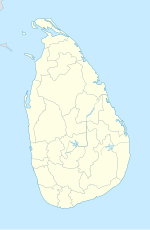Battle of Gannoruwa
| Battle of Gannoruwa | |||||||
|---|---|---|---|---|---|---|---|
| Part of Sinhalese–Portuguese War | |||||||
|
|||||||
| Belligerents | |||||||
| Sinhalese king's army | Portuguese army | ||||||
| Commanders and leaders | |||||||
|
Rajasinghe II Wijayapala |
Diogo de Melo de Castro Fernão de Mendonça Furtado |
||||||
| Strength | |||||||
| Unknown | 900 Portuguese 5,000 mercenaries |
||||||
| Casualties and losses | |||||||
| Unknown | 4,000 (approximately) | ||||||
|
|
|||||||
The Battle of Gannoruwa was a battle of the Sinhalese–Portuguese War fought in 1638 between the occupying Portuguese forces and the Sinhalese King's army at Gannoruwa in the District of Kandy, Sri Lanka. The Portuguese had attempted three times without success to capture the Kingdom of Kandy, in order to bring the entire country under their rule. In 1635, Rajasinghe II became the king of Kandy and started negotiations with the Dutch to obtain their help in driving out the Portuguese. The Portuguese hastened their efforts to take Kandy because of this, and Diogo de Melo de Castro, the Portuguese Captain General, tried to provoke the Sinhalese on several occasions.
Melo seized an elephant presented to a merchant by the king, to which the king responded by seizing two of Melo's own horses. Following this incident, Melo assembled his troops and set out for Kandy. The city of Kandy was evacuated by the Sinhalese, and Melo's army found the city empty when they arrived. They sacked and burned the city, and started to return to Colombo. However, their way forward was blocked by the Sinhalese army at Gannoruwa. The Portuguese force was surrounded with all escape routes cut off.
On 28 March 1638, the Sinhalese army attacked the Portuguese force, leaving only 33 Portuguese soldiers alive, along with a number of mercenaries. The heads of the killed Portuguese soldiers were piled before the Sinhalese king Rajasingha II . The battle, which ended in victory for the Sinhalese army, was the last battle fought between the Portuguese and the Sinhalese, and was also the final battle fought by the Kingdom of Kandy. The Portuguese were driven out of the country by the Dutch soon afterward.
The Portuguese first landed in Sri Lanka in 1505. The aim of the Portuguese was to capture the entire island. which was split into several kingdoms. By 1619, they were in control of the kingdoms of Kotte, Sitawaka and Jaffna. Kandy was the only remaining kingdom under the native king's rule. The Portuguese attempted to capture Kandy in 1594, 1603 and 1630, but were defeated on all three occasions. In 1635, with the death of King Senarath, the kingdom was split into three parts. His son became the king of Kandy as Rajasinghe II, and Rajasinghe's cousins, Wijayapala and Kumarasinghe, were given control of the Matale and Uva areas. Rajasinghe, earlier known as Maha Asthana, had fought against the Portuguese at the Battle of Randeniwela along with his father and cousins in 1630. Rajasinghe II began negotiations with the Dutch to get their help in defeating the Portuguese. As a result of this, the Portuguese hastened their attempts to capture Kandy. Diogo de Melo de Castro was the Portuguese Captain General in Colombo, having been appointed to that position in 1633.
...
Wikipedia

